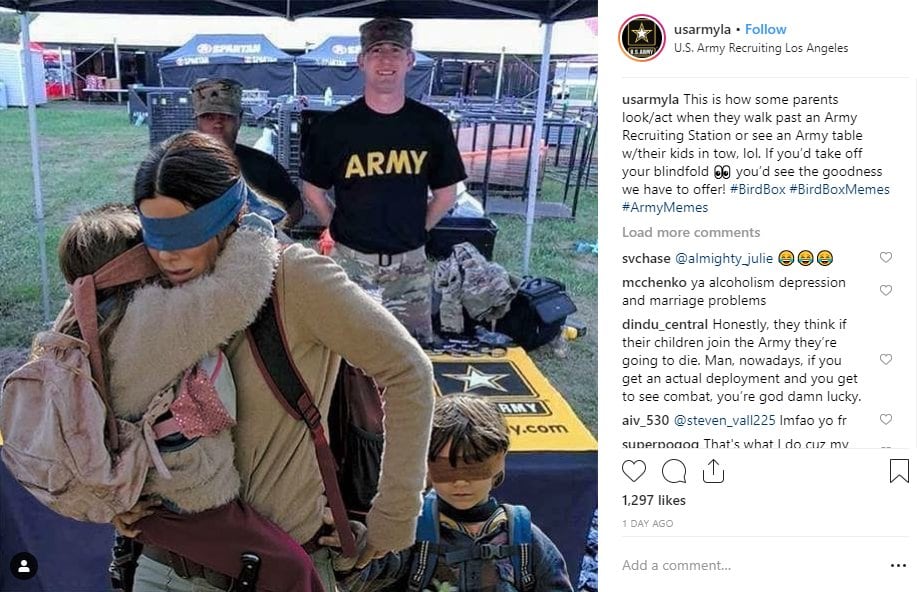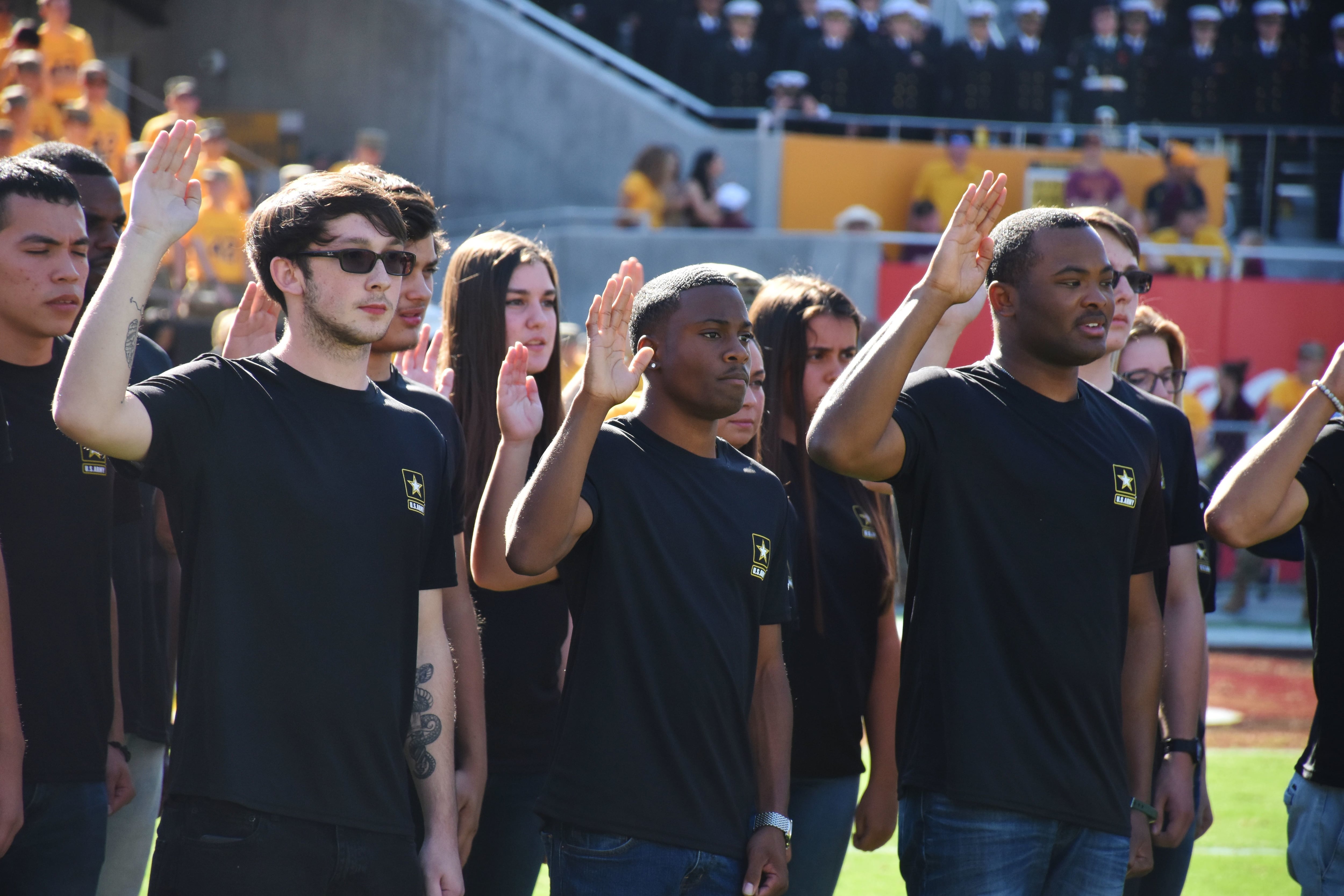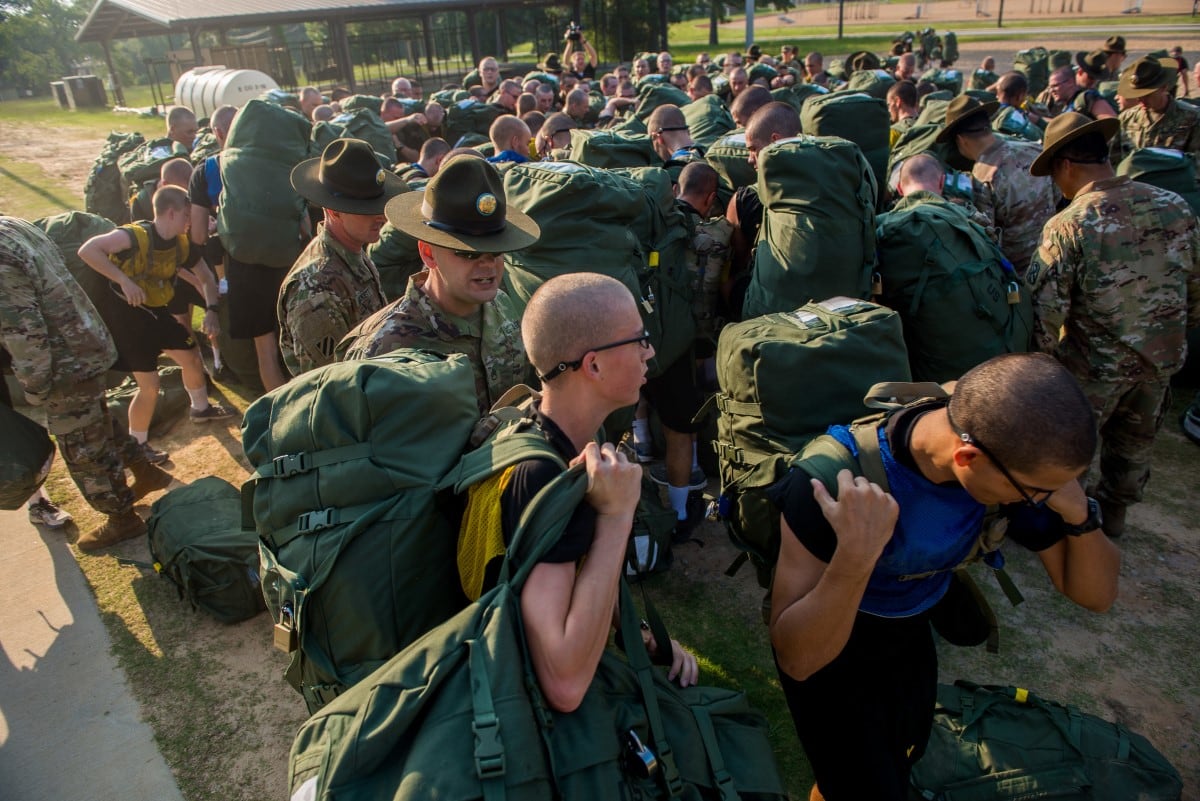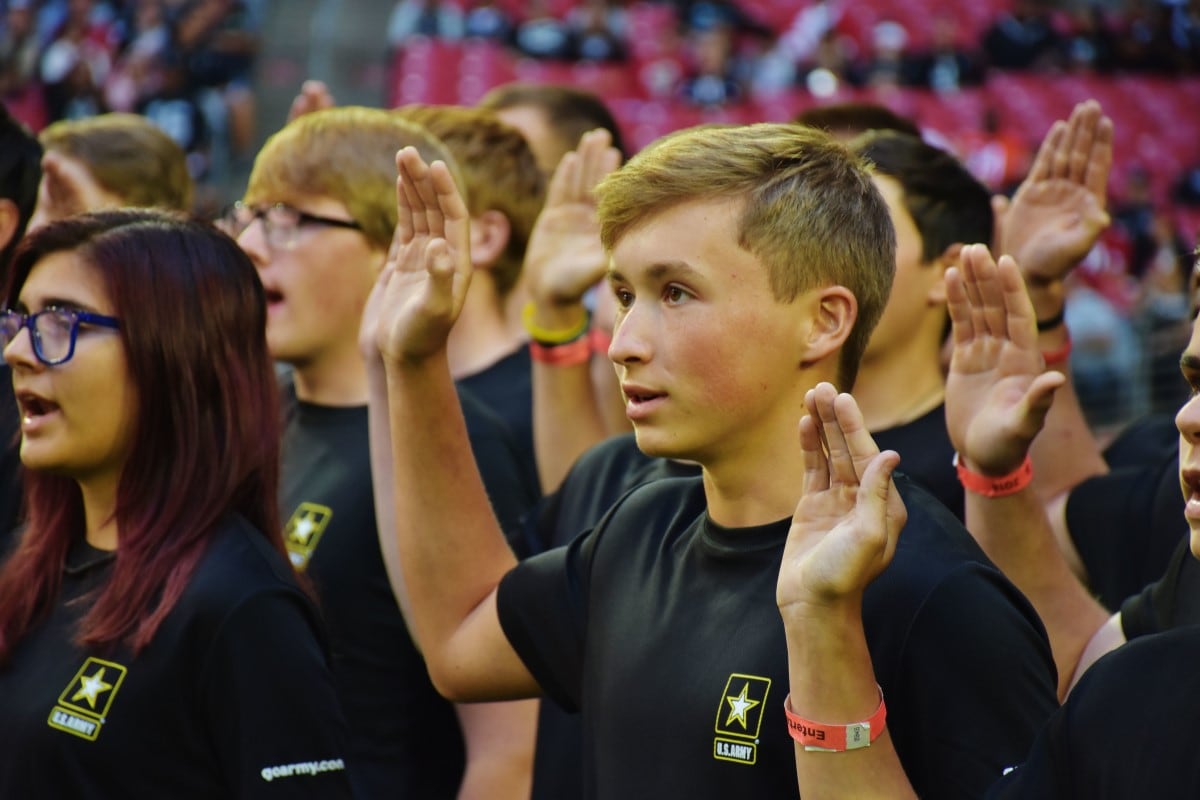There’s really no way to sugarcoat it: Being an Army recruiter is a grueling, frustrating job, and many noncommissioned officers who get that selection phone call dread the cutting of those new orders.
And while that’s not the only experience to be had in recruiting, it is a common one, and one that Army leadership is trying to address.
Army leadership has in recent months lamented an “industrial era,” “brute force” approach to recruiting that got the job done well enough in the last decades of the 21st century but is deeply lacking for today.
With that came what some recruiters have called a pervasive toxic command climate, where NCOs were pressured to make endless cold calls and frenzied follow-ups with leads, and if they didn’t make numbers, there would be consequences ― like more Saturday shifts and training with the sergeant major over the holidays.
“Operating that way is just so counter to my leadership style and to our philosophy,” Maj. Gen. Frank Muth, the head of Army Recruiting Command, told Army Times in a Jan. 14 phone interview.
In fiscal year 2018, the Army gave itself an ambitious, out-sized goal: Bring 80,000 new soldiers into the force.
At about the half-year mark, that number dropped to 76,500, as historically high retention rates took some of the pressure off recruiting.
But recruiting stations were still feeling the strain, working with their highest quotas in a decade and a shortage of about 400 personnel, because while the Army had been looking forward to an end strength increase that kicked off in early 2017, the recruiter selection and training process had not surged in time to meet the new accessions demand.
In the end, Army leadership announced in September, they missed the goal by 6,500.
The after-action reports had several conclusions: The Army needs to keep the recruiting billets at a level commensurate with increased accessions goals during an end strength build-up; marketing needs a complete overhaul, to include commercials, promotional events, research and social media; and the recruiting focus must turn from mainstay Southern and Midwestern towns toward large, highly populated urban areas.
Much has been said about USAREC’s new lease on life, with targeted demographic data, a revamped website and advertising ― including the fresh “Warriors Wanted” slogan ―, and a robust social media presence. A 21st century recruiting enterprise will help the Army create the 21st century force it needs to dominate the conflicts they see on the horizon, leaders say.
And at the same time, Muth and Command Sgt. Maj. Tabitha Gavia, USAREC’s senior enlisted leader, are trying to lead by example, paying special attention to morale, as they spend their time traveling to recruiting stations around the country.
“I’m of the belief that you don’t need to utilize those philosophies to emphasize the importance and to drive numbers in recruiting,” he said of harsh command cultures.
The way ahead
There are 22 cities on USAREC’s list of major metropolitan regions with somewhat untapped populations of 18- to 24-year-olds.
In mid-January, Muth hit the road with Gavia to cover a major swath of the West Coast, to see how things are going and to spread the news on how they’re going to make it better.
The two hit Orange County, Los Angeles, San Luis Obispo, Morro Bay, Portland and Seattle over several days.
The trip came a week after the New York Times published a story about the Army zeroing in on “liberal-leaning cities,” and while the characterization is accurate, politics are not part of the strategy, the head of Army Training and Doctrine Command told Army Times on Jan. 7.
“That’s not how we see it. In fact, some of these cities, you can’t characterize them that way,” Gen. Stephen Townsend said. “We see it as a growing population.”
RELATED

Many soldiers selected for recruiting end up stationed in or near their hometowns, with the idea that they can relate to the kids growing up there, and they can take those years to spend more time around family and old friends.
But other than that, Townsend said, recruiting stations weren’t working off of any real intelligence on their areas of operations. So, now the Army is doing the research to find out what matters to the parents and teenagers they’re trying to engage.
They’re also taking a different, more simplified approach to outreach. Recruiters have told leadership that when they ask young people why they haven’t considered Army service, they tend to have much the same response.
“They say, ‘Well, I don’t really know anything about it,' ” Townsend said.
And what they do know, Muth said, might sway them far in the other direction.
“The first thing is, of course, they think of the Army as infantry, armor and artillery,” Muth said. "And when you say, ‘Well, we have 150 jobs,’ they go, ‘What?’ "
The U.S. Army Career Navigator app can really open their eyes, Gavia said. And so can engaging with stakeholders ― for example, by meeting with educators and community leaders, maybe taking them on a field trip to a nearby Army installation.
“We stress that the Army is a choice, and with that choice, you get a job, you can get an education, and even a technical certificate or a license,” Gavia said.
Leadership also wants to empower the NCOs themselves to chart new territory in the recruiting game.
Step 1: Social media.
“The reason we weren’t on it earlier — apparently the Army made a foray into that space, and some guys got themselves into bad places,” Townsend said. “So, instead of trying to figure out how to do it well, the Army just shut it down.”
But the 2018 postmortem made it abundantly clear that the Army was not going to be able to reach young people by telephone alone, so recruiters got the go-ahead to fire up Instagram, Twitch and others.
With that move, USAREC published some social media rules of engagement. Among their tips are:
- Be professional. Creativity is encouraged, but it must still represent the Army and its values.
- Do not use political posts or endorsements.
- Before you post, ask yourself: What message am I sending about soldiers and the Army?
“We know there’s going to be contentious discussion and dialogue, no matter what we do,” Muth said. “But let’s not operate on that same level. Maintain professionalism and go from there.”
Most feeds feature recruiters at events, or future soldiers after taking an enlistment oath. Some have ventured into more edgy territory. In a now-deleted post, the Los Angeles Recruiting Battalion tapped into the social media frenzy around Netflix’s “Bird Box” movie.

“That is not even close to the tone and texture, and the philosophy, that has been established by myself and Command Sgt. Maj. Gavia,” Muth said.

Those responsible for the exchange have been reminded of the rules, Muth added.
“That’s just not the way we’re going to engage with the American public,” he said.
How they are engaging, officials have said, is by meeting America’s youth where they are.
According to Army research, they are very much gaming online or watching their favorite gamers on a Twitch live stream. So, the Army is going to them.
More than 6,500 soldiers have signed up to fill about 20 spots on the service’s esports team, which will travel to gaming tournaments and live stream their own sessions when they’re not on the road.
Even if you’re not part of the unit, Muth said, he wants recruiters to get on the bandwagon as well.
“We’re encouraging recruiting stations to buy gaming systems and enter local competitions,” he added.
USAREC is also offering incentives, to make the job more palatable, if not easier. In October, current recruiters got an offer to receive an extra $1,500 a month if they agreed to extend their three-year orders for two more.
The move was meant to fill a 390-billet shortfall in the recruiter force, with a Jan. 15 deadline. Recruiter billets are now filled at 100 percent, USAREC spokeswoman Lisa Ferguson told Army Times on Jan. 22.
For those still interested in a bonus, a new program allows recruiters to extend their orders for between 90 days and 12 months, receiving $1,500 per committed month in a lump sum.
In the meantime, the command team is continuing its trips to recruiting stations around the country and holding operational assessments at the battalion and brigade levels. The meetings give leadership a chance to “look them in the eye” and tell them, “This is how we conduct business,” Gavia said.
“They’re understanding that they are empowered to take the mission by the horns and accomplish it,” she said of the feedback she received during her West Coast trip. “Everyone around them, Gen. Muth and myself, we are there to support the recruiter on the ground.
“There’s an uplift in morale,” Muth added. “That is clear. It’s palpable.”
‘Toxic command climate’
That boost can’t come quickly enough for many recruiters.
There are always a handful of factors at play that can affect the recruiting environment. A bad economy, as was the case about a decade ago, can really drive enlistments as high school graduates try to line up jobs.
But a high operational tempo and dozens of news stories about fallen troops, as was the case a decade ago, can detract from the attractiveness of sending one’s child into military service.
The Army clocked some of its highest recruiting numbers as the U.S. surged troops in Iraq and then in Afghanistan, but it wasn’t easy getting there. It involved a lot of waivers for past misconduct, and the pace took a toll on the NCOs working to get them cleared.
Now, as the Army faces a mandate to grow in the face of a much improved economy, and a declining number of American youth who are physically and behaviorally sound enough to serve, tensions have ratcheted up.
This frustration blossomed in 2017 when an Army recruiter, whose identity has been withheld to prevent any career repercussions, ventured onto Facebook to set up the Truth of Army Recruiting page.
"So, I was sitting around my house one day and just thought to myself, ‘What can I do to help spread knowledge and what recruiters actually go through?’ " the administrator told Army Times.
It started as an anonymous outlet for rants and raves, but soon picked up followers and a few post shares from the popular U.S. Army W.T.F! Moments Facebook page.
“The page shares everything good, bad or indifferent about USAREC,” he said. “It’s my opinion that this current command is trying to change USAREC for the better.”
But that hope comes out of dark experience.
“For many years, the one constant was toxic leadership being developed and the stigma recruiting has carried,” he said. “USAREC has always treated its people poorly and wonders why people have so much negative to say.”
And, he added, junior leaders who cut their teeth in recruiting have carried those toxic methods into roles with more and bigger responsibilities.
In May, the commander of the Texas-based 5th Recruiting Brigade drafted a memo threatening to increase Saturday shifts and extend weekday hours because of unmet quotas.
In December, the commander of the Mid-Atlantic recruiting battalion sent a scathing memo to his force, announcing that those recruiting stations who had not made mission would be spending their traditional holiday half-time schedule in full-time remedial training with the sergeant major.
RELATED

That memo quickly made its way to Truth of Army Recruiting and may have been the catalyst for some change up top ― starting with holiday schedules.
“A big part of the page is to expose those people, because there are some good leaders out there, but the problem is that there are only a few, not many,” the admin said.
Starting this year, recruiters will have holiday leave from Dec. 24 to Jan. 2, Muth said.
“I do believe the current command team wants to help purge the middle layer to change the culture of recruiting for the better, but it’s so poisoned from the previous command team and many before, it’s near impossible,” the admin said.
His hope is that beyond exposing toxic leaders, his page gives other recruiters a place to go for advice, and a place to congratulate each other when a job is well done.
“It’s all about them and trying to help them out,” he said. “They always have an anonymous place to vent here.”
Undermanned and under pressure
While Muth and Gavia work to set a positive example for leadership at USAREC, the strain of a somewhat anemic force still figures heavily. The Army is shooting for about 66,000 new soldiers this year, per the 2019 National Defense Authorization Act, while trying to fill empty recruiter billets.
The number of vacancies hovered around 400 in 2018, about 5 percent of the roughly 8,000 total force. As of early January, that gap has been filled.
Still, as Army recruiting gets a handle on the way forward, there are concerns in the operational force that the shortage in one organization is only exacerbating the gaps in another.
The Army is short staff sergeants. To address that issue, Sergeant Major of the Army Dan Dailey has spearheaded myriad policy tweaks, including raising retention control points, mandating automatic local board appearances for promotable specialists and sergeants, and offering big retention bonuses to mid-grade NCOs.
The good news is that those changes have shown some success. Army retention is up to 86 percent, a significant boost to its historical 81 percent.
The bad news is that growing the force requires more recruits, and therefore more recruiters and drill sergeants to start off their careers.
And where does one find more recruiters and drill sergeants? In the operational force. And further, infantrymen are the Army’s biggest military occupational specialty, and they are uniquely qualified to develop more potential infantrymen.

On the other hand, according to one senior noncommissioned officer, there are concerns about the standards being used to get there.
Recently, one of his squad leaders was tapped for recruiting duty despite some recent legal trouble, he said.
“In that specific incident ― while we were deployed, he was accused of hazing,” said the NCO, who spoke to Army Times on the condition of anonymity. “The 15-6 returned that it was founded ... so, technically, a little over a year ago now, he was punished under Article 15 for hazing.”
Human Resources Command said it would probably be waived due to the time frame, the NCO said, and to continue filling out the packet.
According to regulation, a substantiated hazing case requires a higher-level review before cutting recruiting orders, but it doesn’t prevent an NCO from recruiting duty. Offenses like sexual assault do, for example.
“The Army continues to ensure that only high quality, morally qualified noncommissioned officers serve as recruiters,” Army spokesman Lt. Col. Emanuel Ortiz told Army Times in a statement. “The Army has not and will not lower qualification standards for recruiting duty.”
The ironic thing, the infantry NCO added, is that this soldier has large holes in his ear lobes from old piercings, so he will probably have his orders canceled anyway. The same thing happened to another guy in the battalion recently, he added.
“It’s very well known in the operational force right now that drill and recruiting are getting ruthless,” the NCO said.
In his division, he said, “at least” two brigades are bleeding experienced NCOs because so many are getting picked up for recruiting or drill sergeant duties.
“When I say ‘tapped out’ ― most platoons only have one or two staff sergeants,” he said. “There should be four. And at least one of those should be seasoned.”
His company has one sergeant first class, which means two other platoons have E-6s serving as their top enlisted leaders.
“Meaning all of your squad leaders ― including the weapons squad leader, who is usually a seasoned staff sergeant ― are newly promoted sergeants,” he said. “You basically have guys who have only been in two or three years themselves now as the most senior squad leader.”
That lack of experience causes dysfunction, he said, which trickles down to the next rotation of soldiers in the units. When they come back from broadening opportunities, the NCO added, their skills have been eroded.
And on top of that, he said, USAREC is reluctant to let recruiters take time off to attend career-advancing schools that are crucial to 11Bs.
Because of the length of some schools ― for instance, two-plus months for Ranger qualification ― the recruiting enterprise is reluctant to loan out its personnel.
“We are working to open further opportunities for professional development, especially occupation-specific schools,” USAREC spokeswoman Lisa Ferguson told Army Times.
If a soldier is interested in a school, they should speak to their career managers and work on a packet anyway, she added.
“These school slots are often attached to a follow-on position and are more likely to be approved as soldiers near the completion of their recruiting assignment,” Ferguson said.
Despite the challenges now, Muth said, recruiters should look to see improvements in the next couple of months, as Army pollsters wrap up their research and push new, precise data to recruiting stations.
With the efficiencies USAREC is working on, like targeted marketing, demographic analysis and more powerful online tools, Townsend said, there’s a possibility the Army won’t be trying so hard to balance the needs of the operational and recruiting forces because they just won’t need as many recruiters.
“I think that it is within our reach, if we do these reforms that we’re talking about, that we can cut the recruiting force by 25 percent, 30 percent – maybe half, I don’t know,” he said.
For now, according to both Muth and Townsend, there are already some early signs that their new philosophy is producing returns on investment.
Four of USAREC’s five general recruiting brigades, comparing the first quarter of 2019 to the same in 2018, have beat their best numbers.
“Last month, six battalions met 100 percent of their mission," Muth said.
Chicago, the test kitchen for new, neighborhood-targeted marketing, beat last year’s first-quarter numbers.
“Two new ones that have not made mission in a long time? [Los Angeles] and Portland," Muth said. “Very difficult markets, and they both made 100 percent last month.”
Meghann Myers is the Pentagon bureau chief at Military Times. She covers operations, policy, personnel, leadership and other issues affecting service members.




